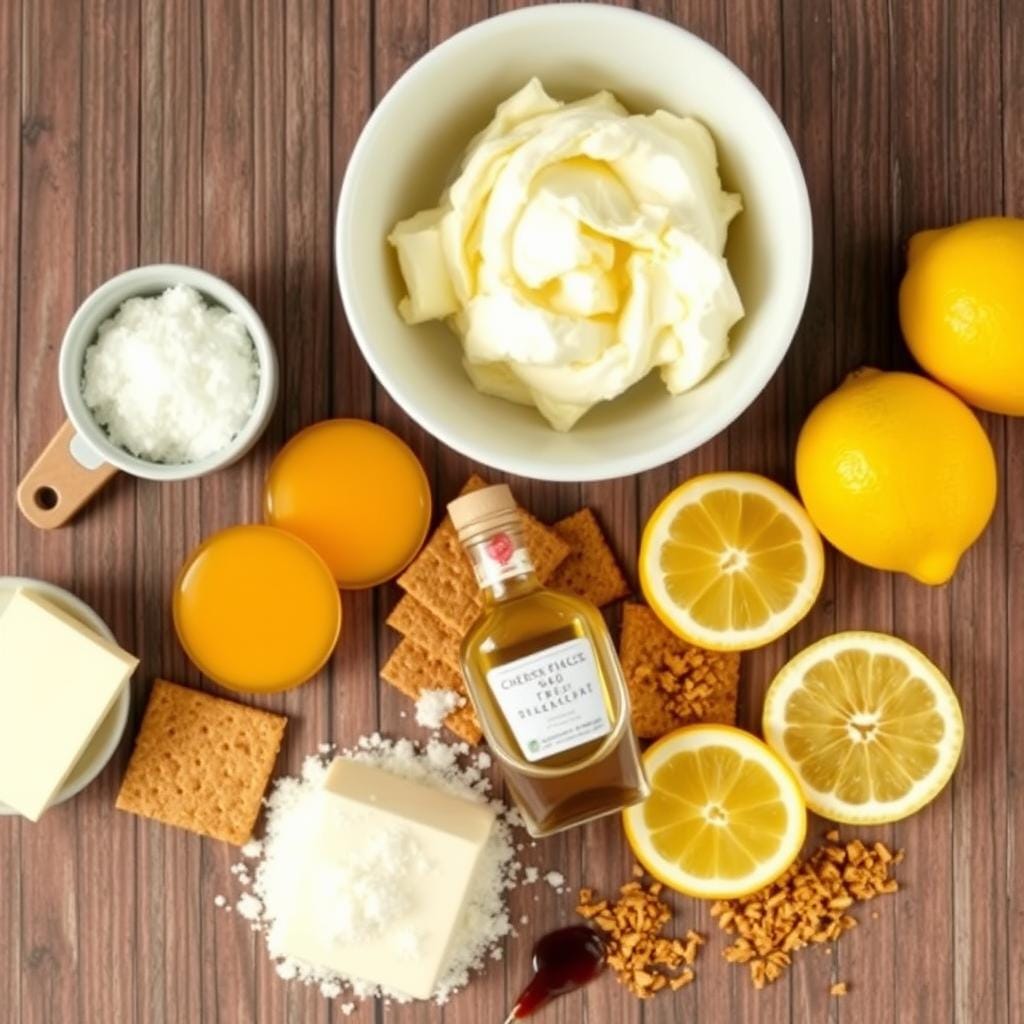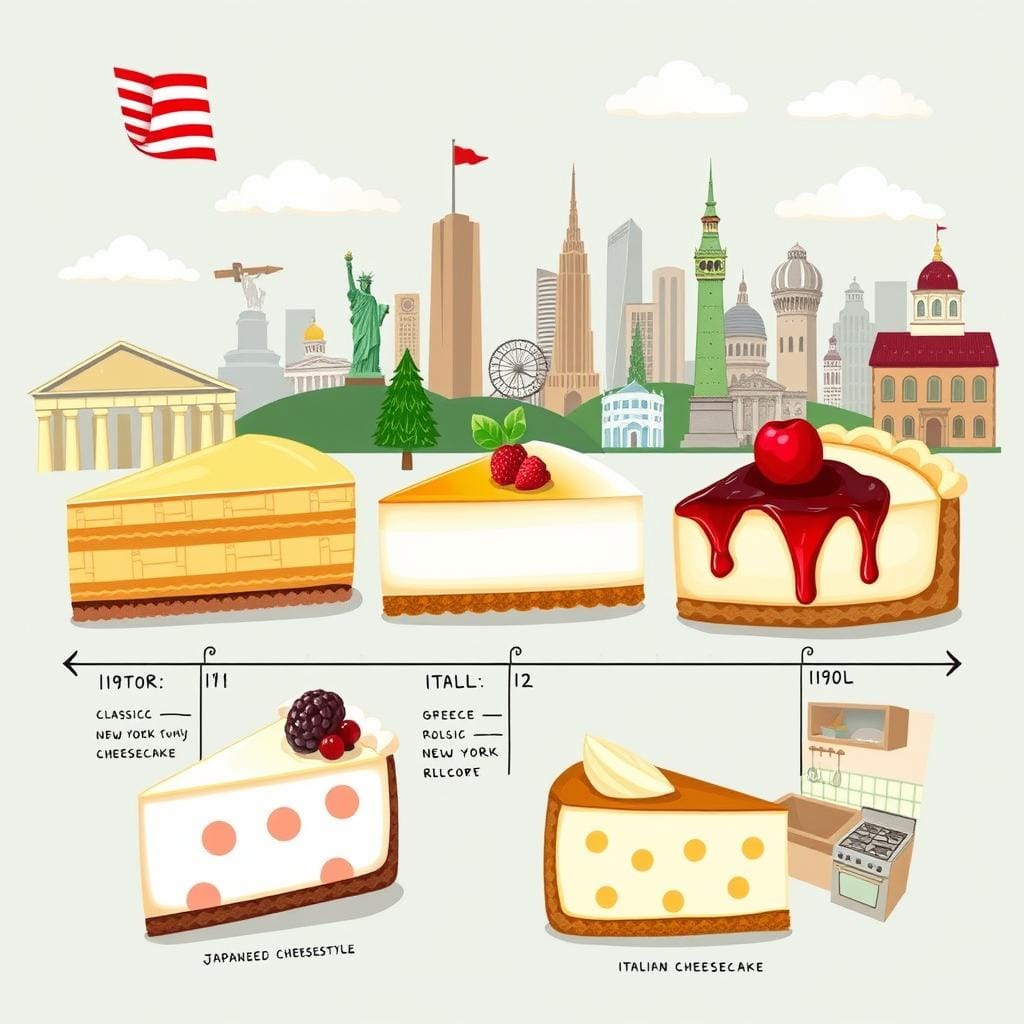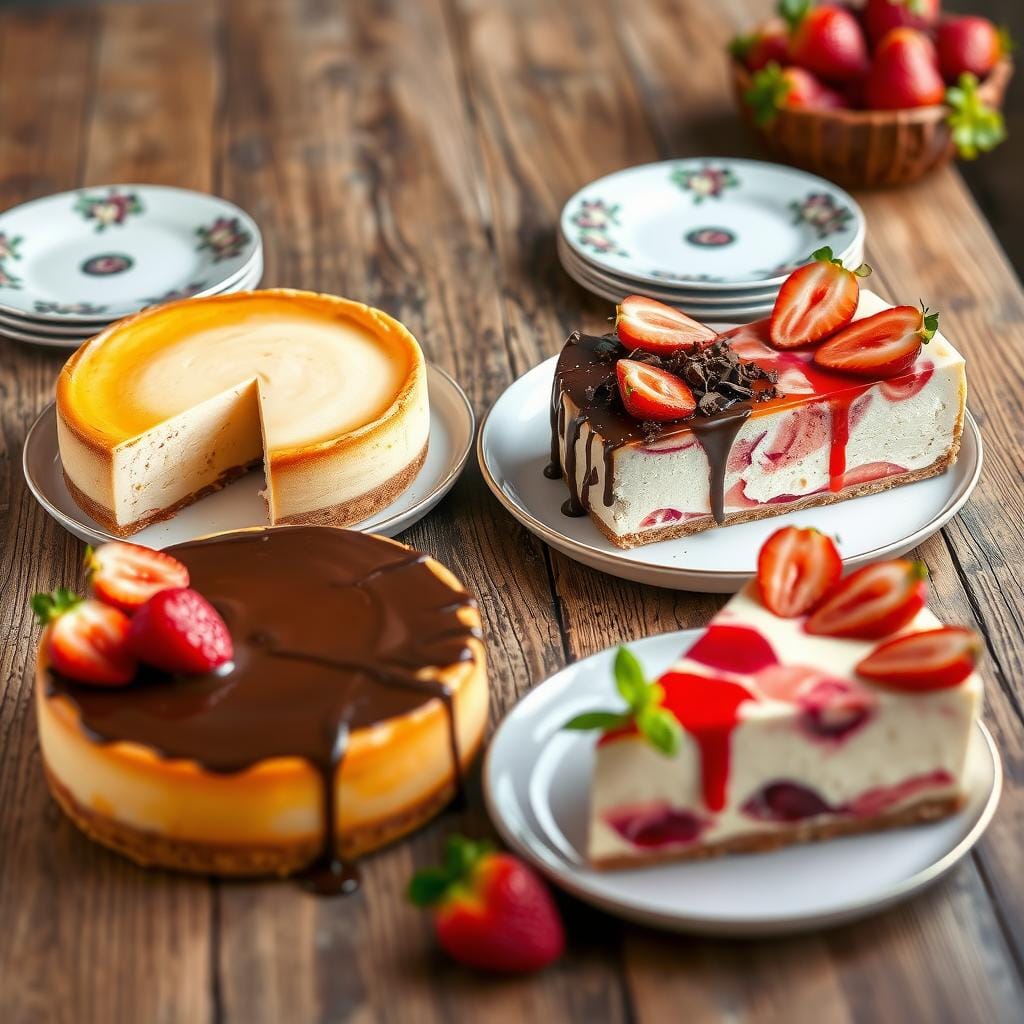I remember the smell of cheesecake in my grandmother’s kitchen. It was so good, it felt like a special treat. As I grew older, I learned more about cheesecake. I found out how many different kinds there are.
In this guide, we’ll look at three main types of cheesecake. You’ll learn about the classic New York-style, the quick no-bake, and the light Japanese “cotton”. Whether you love cheesecake or are new to it, you’ll find out how to make the best slice.
Key Takeaways
- Explore the three main types of cheesecake: New York-style, no-bake, and Japanese cotton cheesecake.
- Learn the essential ingredients and equipment needed to make the perfect cheesecake.
- Discover tips and techniques for baking, setting, and decorating your cheesecakes.
- Uncover the rich history and evolution of this beloved dessert.
- Enjoy a variety of cheesecake flavors, textures, and toppings.
Understanding the Art of Cheesecake Making
Making the perfect cheesecake recipes is both a science and an art. To get the right texture, flavor, and look, you need to know the key ingredients and tools. Also, it’s important to know what mistakes to avoid.
Essential Ingredients for Perfect Cheesecake
The base of a great cheesecake is its ingredients. These are:
- Cream cheese, for a rich, creamy base
- Eggs, to provide structure and a velvety consistency
- Sugar, to balance the tangy cream cheese flavor
- Heavy cream or sour cream, for a luxurious mouthfeel
- Vanilla extract, to enhance the overall flavor profile
Basic Equipment You’ll Need
The right tools are key in making what are the three types of cheesecake?. You’ll need:
- A springform pan, for easy removal of the cheesecake
- A high-quality electric mixer, to ensure a smooth batter
- A food processor or blender, for efficiently combining ingredients
- Parchment paper or a silicone baking mat, for lining the pan
- A water bath (also known as a bain-marie), to gently bake the cheesecake
Common Cheesecake Mistakes to Avoid
Even experienced bakers can face challenges when making cheesecake recipes. Some common mistakes include:
- Overmixing the batter, which can lead to a dense, tough texture
- Failing to properly prepare the springform pan, resulting in sticking or cracking
- Overbaking the cheesecake, causing it to become dry and dense
- Skipping the water bath, which can lead to uneven cooking and cracking
- Rushing the cooling and chilling process, compromising the final texture
Knowing the key ingredients, essential equipment, and common mistakes helps you master what are the three types of cheesecake? making. You’ll be able to make delicious homemade cheesecakes.

The Evolution of Cheesecake Through History
The story of cheesecake history is fascinating. It spans from ancient times to today’s creations. The first classic cheesecake was enjoyed in the 8th century B.C.
The ancient Greeks made the first cheesecake. They used honey, cheese, and wheat flour. These treats were enjoyed at games and weddings, making them special.
When the Roman Empire grew, so did the cheesecake recipe. New ingredients and methods were added.
“Cheesecake has been a part of our culinary heritage for centuries, with each era leaving its mark on this cherished dessert.”
In the Middle Ages, ricotta and cream cheese were introduced. This made cheesecakes richer and creamier. The 18th century brought the New York-style cheesecake. It’s known for its dense texture and graham cracker crust.
Over time, cheesecake history has been influenced by many cultures. From Japan’s cotton cheesecake to Europe’s rich versions, there’s always something new. Today, people worldwide keep cheesecake fresh and exciting.

What Are the Three Types of Cheesecake?
Cheesecake is a dessert loved by many. It’s not just one type, but three. Each has its own special qualities. Let’s dive into the world of cheesecake and see what makes each one unique.
Baked New York-Style Cheesecake
The baked cheesecake comes from New York City. It’s known for its creamy texture and deep flavor. This cheesecake is made by mixing cream cheese, eggs, and sugar carefully.
This mix creates a dessert that’s both rich and indulgent. It’s a treat that melts in your mouth.
No-Bake Cheesecake
The no-bake cheesecake is perfect for those who want something quick. It skips the baking step. Instead, it’s chilled and set on a graham cracker or cookie crust.
This cheesecake is lighter and airier. It’s a refreshing change from the traditional baked version.
Japanese Cotton Cheesecake
The Japanese cotton cheesecake comes from Japan. It’s known for its fluffy texture. This cheesecake is made with whipped egg whites and a special mix of ingredients.
It’s both decadent and delicate. The sweetness is subtle, making it a delight to eat.
Whether you love the richness of a baked cheesecake, the ease of a no-bake one, or the lightness of a Japanese cotton cheesecake, there’s something for everyone. Try each type to find your favorite.
Classic Baked Cheesecake: Techniques and Tips
Making the perfect baked cheesecake is an art that needs precision and patience. It involves the water bath technique, controlling temperature, and cooling methods. These steps are key to getting the right texture and avoiding cracks.
The water bath, or “bain-marie,” method is a secret to a flawless cheesecake. It bakes the cheesecake in a water-filled pan for even heat. This results in a smooth and crack-free finish. Keeping the oven temperature steady is also vital to avoid bad results.
After baking, cooling the cheesecake is just as important. Slowly moving it from the oven to the counter and then to the fridge helps. This prevents sudden temperature changes that can cause cracks. With the right techniques and attention to detail, you’ll make the most decadent and impressive baked cheesecakes.
| Technique | Importance |
|---|---|
| Water Bath | Ensures even, gentle heat distribution for a smooth, crack-free texture. |
| Temperature Control | Maintaining the correct oven temperature is crucial to prevent cracking and achieve the ideal baking result. |
| Cooling Process | Gradual temperature transition from oven to counter to refrigerator helps prevent cracking. |
“The secret to a perfect baked cheesecake lies in the details – from the water bath to the cooling process. With the right techniques, you can create a dessert that’s truly worthy of a standing ovation.”
No-Bake Cheesecake: The Quick Alternative
No-bake cheesecakes are perfect when you’re short on time. They’re creamy and delicious, needing no oven. This makes them great for busy days or when it’s hot outside. Whether you’re new to baking or experienced, learning to make no-bake cheesecakes opens up a world of possibilities.
Setting Times and Temperature Guidelines
Getting a no-bake cheesecake right is all about setting. Unlike baked ones, no-bake cheesecakes set in the fridge. Make sure to chill them for 4-6 hours or overnight before serving. Keeping the fridge at 40-45°F is key for the right texture.
Texture and Consistency Tips
For the perfect no-bake cheesecake texture, balance is key. Avoid a grainy feel by watching the cream cheese ratio. Adding whipped cream or yogurt can make it silkier. Try different recipes to find your favorite texture.
Popular No-Bake Variations
- Classic Vanilla: A timeless flavor that showcases the natural richness of the cream cheese.
- Chocolate Swirl: Melted chocolate or cocoa powder folded into the batter for a decadent twist.
- Fruit-Infused: Fresh or frozen berries, citrus, or tropical fruits can add a refreshing note.
- No-Bake Oreo Cheesecake: Crushed Oreo cookies in the crust and throughout the filling.
No-bake cheesecakes are incredibly versatile. Try different flavors and toppings to make your own unique dessert. It will satisfy your cravings and wow your guests.
“The best thing about no-bake cheesecake is that it’s so easy to make, yet it tastes like you spent hours in the kitchen.” – Chrissy, Chrissy Recipes
Creating the Perfect Cheesecake Base
Making the perfect cheesecake base is key to a great classic cheesecake or any cheesecake recipes. Choosing the right crust and mastering the filling texture are crucial. Each step helps create a delicious flavor and a delightful experience.
The crust is often overlooked but it’s vital. A traditional graham cracker crust is popular, but you can try cookie crumbs, ground nuts, or a buttery pastry base. Make sure to press the crust firmly into the pan for a solid base.
For the filling, finding the right balance is essential. You want it to be creamy but also light. Use the right ingredients, mix well, and bake gently to get it just right.
- Make sure all ingredients, like cream cheese, eggs, and sugar, are at room temperature for easy mixing.
- Beat the batter gently to avoid too much air, which can cause cracking or a dense texture.
- Watch the baking closely to avoid overcooking, which can make the cheesecake dry and crumbly.
Mastering the cheesecake base will make your dessert a hit. It will impress your guests and satisfy their taste buds.
“Baking a cheesecake is like creating a work of art – every step must be executed with precision and care.”
Essential Toppings and Decorative Elements
Adding the right toppings and decorations can make a simple cheesecake special. You can use fresh fruits or get creative with garnishes. There are endless ways to make your dessert stand out.
Fresh Fruit Options
Top your cheesecake with fresh berries like strawberries, blueberries, or raspberries for a classic look. But try other fruits like mango, pineapple, or kiwi for something new. This will make your cheesecake both tasty and beautiful.
Sauce and Syrup Combinations
Drizzling a cheesecake with sauce or syrup can elevate it. Choose from caramel, chocolate, balsamic reduction, or fruit compote. These toppings add flavor and make your dessert look amazing.
Creative Garnishing Ideas
There are many ways to garnish your cheesecake. Try sprinkling chopped nuts like pecans or almonds for a crunchy touch. Shaved chocolate, crumbled cookies, or cocoa powder add texture and depth. For a savory twist, try sea salt or olive oil.
| Topping | Flavor Profile | Visual Impact |
|---|---|---|
| Fresh Berries | Sweet, Tangy | Vibrant, Colorful |
| Caramel Sauce | Rich, Indulgent | Glossy, Drizzled |
| Chopped Nuts | Nutty, Crunchy | Textural, Sprinkled |
“The beauty of a cheesecake is that it can be a blank canvas, allowing you to experiment with a variety of toppings and decorations to create a truly unique and visually stunning dessert.”
Storing and Serving Your Cheesecake
Keeping your homemade cheesecake recipes or store-bought classic cheesecake fresh is key. Use these tips to keep your cheesecake delicious and looking great for any event.
Proper Storage Methods
Storing your cheesecake right is crucial. Chill it in the fridge, covered with plastic wrap or in an airtight container. This stops it from drying out or picking up bad tastes. Enjoy your cheesecake within 3-5 days for the best taste.
Serving at the Right Temperature
Before serving, take your cheesecake out of the fridge 30 minutes early. This makes it just right, soft and full of flavor. Don’t serve it straight from the fridge, as it can be too cold and dense.
Decorative Presentation Ideas
- Top the cheesecake with fresh fruit, such as berries, sliced kiwi, or a drizzle of fruit compote or caramel sauce.
- Garnish the plate with a sprig of mint, a dusting of cocoa powder, or a sprinkle of chopped nuts for a visually appealing display.
- Consider serving individual slices on decorative plates or in dessert cups for a more elegant presentation.
By following these tips, your homemade or store-bought cheesecake will stay fresh, tasty, and look amazing for everyone to enjoy.
Conclusion
We’ve looked at the three main types of cheesecake that everyone loves. These are the classic baked New York-style, the quick no-bake, and the light Japanese cotton cheesecake. Each one has its own special texture, taste, and look, pleasing many different tastes.
If you love cheesecake or are just starting to explore, try out these cheesecake varieties. Enjoy the creamy taste of a baked New York-style, the soft Japanese cotton, or the easy no-bake. There’s so much to try with what are the three types of cheesecake.
Keep exploring cheesecake and remember, the fun is in making and sharing it. Get creative and find your own special cheesecake flavors and textures. Enjoy every bite!

